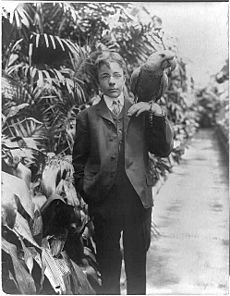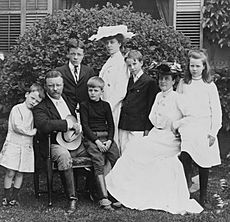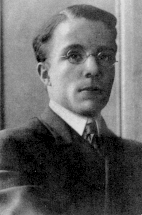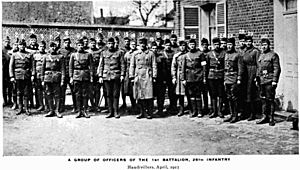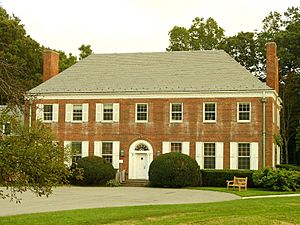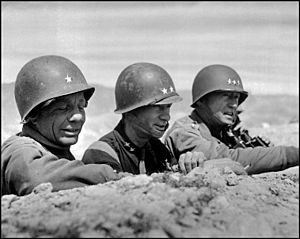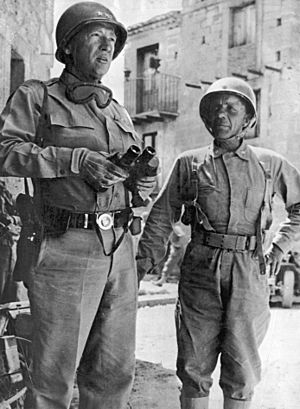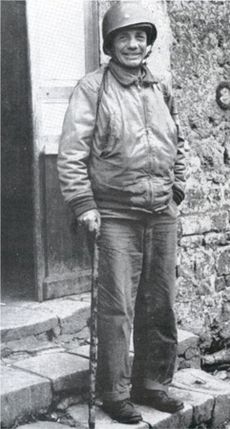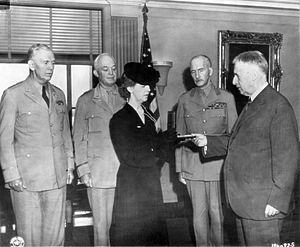Theodore Roosevelt Jr. facts for kids
Quick facts for kids
Theodore Roosevelt Jr.
|
|
|---|---|
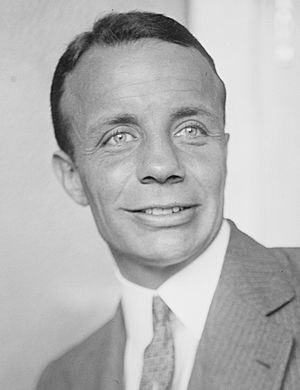
Roosevelt, c. 1921
|
|
| Governor-General of the Philippines | |
| In office February 29, 1932 – July 15, 1933 |
|
| President | Herbert Hoover Franklin D. Roosevelt |
| Preceded by | Dwight F. Davis |
| Succeeded by | Frank Murphy |
| Governor of Puerto Rico | |
| In office September 9, 1929 – January 1932 |
|
| President | Herbert Hoover |
| Preceded by | James R. Beverley (acting) |
| Succeeded by | James R. Beverley |
| Assistant Secretary of the Navy | |
| In office March 10, 1921 – September 30, 1924 |
|
| President | Warren G. Harding Calvin Coolidge |
| Preceded by | Gordon Woodbury |
| Succeeded by | Theodore Douglas Robinson |
| Member of the New York State Assembly from the 2nd district |
|
| In office 1920–1921 |
|
| Preceded by | Franklin A. Coles |
| Succeeded by | Frederick Trubee Davison |
| Personal details | |
| Born |
Theodore Roosevelt III
September 13, 1887 Oyster Bay, New York, U.S. |
| Died | July 12, 1944 (aged 56) Méautis, France |
| Resting place | Normandy American Cemetery 49°20′55″N 0°51′17″W / 49.34861°N 0.85472°W |
| Political party | Republican |
| Spouse |
Eleanor Butler Alexander
(m. 1910) |
| Children |
|
| Parents | Theodore Roosevelt Edith Roosevelt |
| Military service | |
| Allegiance | United States |
| Branch | United States Army |
| Years of service | 1917–1919 1940–1944 |
| Rank | Brigadier General |
| Unit | 1st Infantry Division 4th Infantry Division |
| Commands | 1st Battalion, 26th Infantry 26th Infantry |
| Campaigns |
|
| Awards |
|
Theodore Roosevelt III (born September 13, 1887 – died July 12, 1944), often called Theodore Jr., was an American leader. He worked in government and business. He was also a military leader.
He was the oldest son of President Theodore Roosevelt and First Lady Edith Roosevelt. Theodore Jr. is famous for his service in World War II. He led troops at Utah Beach during the Normandy landings. For his bravery, he received the Medal of Honor.
Roosevelt went to private schools and Harvard University. After graduating in 1909, he started a successful career in business. He also gained military experience before World War I. When the war began, he became a major. He served with the 1st Division. He fought in battles like Battle of Cantigny. He commanded the 1st Battalion, 26th Infantry. After the war, he helped create The American Legion.
Besides his military and business work, Roosevelt was active in politics. He was Assistant Secretary of the Navy (1921–1924). He also served as Governor of Puerto Rico (1929–1932). Later, he was Governor-General of the Philippines (1932–1933). In the 1930s, he returned to business. He became Chairman of the Board for American Express Company. He was also vice-president of Doubleday Books.
He stayed active in the Army Reserve. He attended training and completed advanced courses. For World War II, he returned to active duty as a colonel. He commanded the 26th Infantry. Soon, he became a brigadier general. He was the assistant division commander of the 1st Infantry Division.
He served in the Operation Torch landings in North Africa. He also fought in the Tunisia Campaign and the Allied invasion of Sicily. After this, he became assistant division commander of the 4th Infantry Division. In June 1944, he led the first wave of troops onto Utah Beach during the Normandy landings. He died in France from a heart attack the next month. He was recommended for the Distinguished Service Cross. This recommendation was later upgraded. He received the Medal of Honor after his death.
Contents
Early Life and Family
Theodore Jr., or Ted, was the oldest son of President Theodore Roosevelt and First Lady Edith Kermit Carow. He was born at his family's home in Oyster Bay, New York. His father was just starting his political career then. Even though he was called "Jr.", he was actually Theodore III. One of his own sons was Theodore IV.
His brothers were Kermit, Archie, and Quentin. His sisters were Ethel and half-sister Alice. Ted came from the Oyster Bay Roosevelts. He was also a descendant of the Schuyler family.
Like all the Roosevelt children, Ted was greatly influenced by his father. Ted later wrote about his childhood memories. One day, when he was about nine, his father gave him a rifle. When Ted asked if it was real, his father loaded it. He then shot a bullet into the ceiling.
Ted recalled his first time in Washington. He often walked to his father's office. His father would tell him history stories. These were not boring dates, but exciting tales. His father would draw battle plans in the dust with his umbrella. Even before World War I, his father talked about military training. He believed every man should be ready to serve.
Education and Business Career
The Roosevelt boys went to private schools. Ted attended The Albany Academy and then Groton School. Before college, he thought about military school. He worked hard and graduated from Harvard College in 1909. Like his father, he joined the Porcellian Club.
After college, Ted started in business. He worked in the steel and carpet industries. Then, he became a branch manager for an investment bank. He was good at business. He earned a lot of money before World War I and into the 1920s. This money helped him pursue a career in politics after the war.
World War I Service
All the Roosevelt sons, except Kermit, had some military training. This was before World War I began. In August 1914, World War I started in Europe. American leaders worried about their nation's military readiness. In 1915, Major General Leonard Wood organized a summer camp. This camp at Plattsburgh, New York trained businessmen. They paid for their own training.
This summer program helped create many junior officers. When the United States entered World War I, these trained men received military ranks. The National Defense Act of 1916 made these training programs official. It created the Officers' Reserve Corps and ROTC.
When the U.S. declared war on Germany, Ted was called to serve. He volunteered to be one of the first soldiers on the Western Front. His division commander said he was the best battalion commander. Roosevelt faced enemy fire and gas attacks. He led his battalion bravely. He cared so much for his men that he bought combat boots for them with his own money.
He eventually commanded the 26th Regiment. He was a lieutenant colonel. He fought in major battles, including America's first victory at the Battle of Cantigny.

Ted was wounded and gassed at Soissons in 1918. In July, his youngest brother Quentin was killed in combat. Ted received the Distinguished Service Cross for his actions. France also gave him the Chevalier Légion d'honneur.
Before troops returned home, Ted helped found The American Legion. This organization was for soldiers. A group of officers planned it in France. They wanted to improve troop morale. Ted suggested an organization for veterans. The first meeting was in Paris in March 1919. About 1,000 officers and enlisted men attended. They adopted a temporary constitution and the name The American Legion.
When The American Legion met in New York City, Ted was nominated as its first national commander. But he declined. He did not want people to think he was using it for political gain. He believed accepting might harm the new organization. It could also hurt his future in politics.
Ted continued his reserve service between the wars. He attended summer camps. He completed officer courses and staff college. By World War II, he was ready for senior military service.
Political Career and Public Service

After World War I, Roosevelt started his political career. He looked and acted like his father. He participated in almost every national campaign. He was elected to the New York State Assembly in 1920 and 1921. He was one of the few who opposed removing five Socialist assemblymen in 1920.
On March 10, 1921, President Warren G. Harding appointed Roosevelt as Assistant Secretary of the Navy. He oversaw the transfer of oil leases. These were for federal lands in Wyoming and California. They went from the Navy to the Department of Interior. Finally, they went to private companies. These lands were Navy petroleum reserves.
In 1922, the Secretary of the Interior leased these lands. This was done without competitive bidding. This deal became known as the Teapot Dome scandal. Ted's brother, Archie, worked for one of the oil companies. Both Ted and Archie were cleared of charges. But their reputations were still affected.
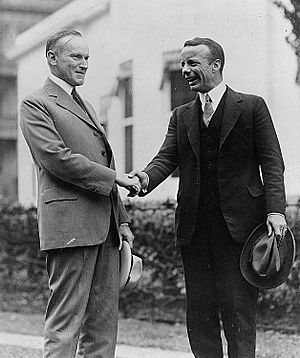
In 1924, Roosevelt ran for Governor of New York. His cousin Franklin Delano Roosevelt (FDR) criticized his record. Ted said FDR was "a maverick" and not like their family. Eleanor Roosevelt, who was related to both, was angry. She followed Ted on his campaign. She used a car with a giant teapot on it. It made fake steam. She called him immature.
She later said these methods were beneath her. She blamed Democratic Party "dirty tricksters." Ted lost the election. He never forgave Eleanor for her stunt. These conflicts made the split between the two Roosevelt family branches wider.
Governor of Puerto Rico
In 1929, President Herbert Hoover appointed Roosevelt as Governor of Puerto Rico. He served until 1932. This was a political appointment until 1947. Roosevelt worked to help the people during the Great Depression. He brought money to build schools. He raised funds from American charities. He promoted Puerto Rico for manufacturing. He tried to improve the Puerto Rican economy.
He worked to connect Puerto Rico more with U.S. institutions. He wanted mutual benefits. For example, he arranged for a Puerto Rican lawyer to lecture at Harvard Law School. He also arranged for a Puerto Rican assembly member to speak in New York City. Roosevelt worked to teach Americans about the island. He wanted to improve Puerto Rico's image in the U.S.
Roosevelt was the first American governor to learn Spanish. He tried to learn 20 words a day. He liked local Puerto Rican culture. He adopted many island traditions. Locals called him El Jíbaro de La Fortaleza. This means "The Hillbilly of the Governor's Mansion." In 1931, he appointed the first Puerto Rican to lead the University of Puerto Rico.
Governor-General of the Philippines
President Hoover was impressed with his work in Puerto Rico. So, he appointed Roosevelt as Governor-General of the Philippines in 1932. While in office, Filipinos called him "One Shot Teddy." This was because of his good aim during a hunt for wild water buffalo.
In the 1932 election, Franklin D. Roosevelt ran against Hoover. Ted's half-sister Alice asked him to return from the Philippines to help the campaign. Ted told the press he would return briefly. But the U.S. press reacted negatively. So, he stayed in Manila during the campaign. The Secretary of War told him to remain at his post. Roosevelt resigned after FDR won the election. He knew the new president would appoint his own people.
Return to the U.S. Mainland
After his time as Governor-General, Roosevelt returned to the United States. In 1935, he became a vice president at Doubleday, a publishing company. He then worked as an executive for American Express. He also served on boards of many non-profit groups. He helped manage money from Irving Berlin's song, "God Bless America." This money went to charity.
While living in New York, the Roosevelts reconnected with old friends. These included playwright Alexander Woollcott and comedian Harpo Marx.
World War II Service and Death
In 1940, before the U.S. entered World War II, Roosevelt took a military refresher course. He was promoted to colonel.
Roosevelt's wife asked Army Chief of Staff George C. Marshall to send him back to a combat unit. Marshall usually refused such requests. But he made an exception for Roosevelt. He said he would agree "if what you wanted was a more dangerous job." Roosevelt returned to active duty in April 1941. He commanded the 26th Infantry Regiment. This was the same unit he fought with in World War I. In late 1941, he was promoted to brigadier general.
North Africa Campaigns
When he arrived in North Africa, Roosevelt became known for visiting the front lines. He preferred being in the battle rather than at the command post. This attitude would be very important on D-Day.
Roosevelt led the 26th Infantry in an attack on Oran, Algeria. This was on November 8, 1942. It was part of Operation Torch, the Allies' invasion of North Africa. In 1943, he was the Assistant Division Commander of the 1st Infantry Division. This was during the campaign in North Africa. He received the Croix de Guerre for his bravery.
Working with Patton and Bradley
Roosevelt was friends with his commander, Major General Terry de la Mesa Allen Sr.. Their relaxed approach to warfare was noticed by Lieutenant General George S. Patton. Patton was the Seventh Army commander in Sicily. He did not like officers who were not strict about uniforms. Patton thought they were not soldier-like. He sent negative reports about Allen to General Dwight D. Eisenhower. Roosevelt was also criticized because of his friendship with Allen. When Allen was moved from his command, so was Roosevelt.
Patton later wrote in his diary that Roosevelt was "one of the bravest men I've ever known." He even served as a pallbearer at Roosevelt's funeral.
Lieutenant General Omar Bradley also criticized Roosevelt. Bradley was the II Corps commander. He eventually removed both Roosevelt and Allen from their commands. Bradley felt that Allen and Roosevelt "loved their division too much." He thought their close relationship with soldiers hurt discipline.
Roosevelt was assistant commander of the 1st Infantry Division at Gela. This was during the Allied invasion of Sicily. He also commanded Allied Forces in Sardinia. He fought on the Italian mainland. He was the chief contact officer for the French forces in Italy. He repeatedly asked Eisenhower for a combat command.
D-Day Heroism
In February 1944, Roosevelt went to England. He was there to help lead the Normandy invasion. He was made Deputy Division Commander of the 4th Infantry Division. He asked his commanding general, Major General Raymond "Tubby" Barton, to go ashore on D-Day with the first wave of troops. Barton denied his requests several times. So, Roosevelt sent a written request. He argued that his presence would help the new troops. He also said he could provide accurate information.
Barton finally approved Roosevelt's request. But he worried that Roosevelt would not survive.
Roosevelt was the only general on D-Day to land with the first wave of troops by sea. At 56, he was the oldest man in the invasion. He was also the only one whose son landed that day. His son, Captain Quentin Roosevelt II, was among the first soldiers at Omaha Beach.
Brigadier General Roosevelt was one of the first soldiers off his landing craft. He led the 8th Infantry Regiment and 70th Tank Battalion onto Utah Beach. Roosevelt soon learned that the landing craft had drifted south. The first wave of men was a mile off course. He walked with a cane and carried a pistol. He explored the area behind the beach. He found the paths needed to move inland.
He returned to the landing spot. He contacted the battalion commanders. He coordinated the attack on the enemy positions. Roosevelt decided to fight from where they had landed. He did not try to move to their original positions. His famous words were, "We'll start the war from right here!"
These quick plans worked very well. There was little confusion. Artillery shells landed nearby. But Roosevelt remained calm and collected. He personally welcomed each new regiment on the beach. He inspired everyone with humor and confidence. He even recited poetry and told stories about his father. He helped steady his men's nerves. Roosevelt pointed almost every regiment to its new objective. Sometimes, he acted like a traffic cop under fire. He untangled traffic jams of trucks and tanks. One soldier later said that seeing the general walking around, unaffected by enemy fire, gave him courage.
When Major General Barton came ashore, he met Roosevelt. Barton later wrote that Ted had put his troops across the beach. He had a perfect understanding of the situation. Barton said he loved Ted. He had not expected to see him alive. He was very emotional when he met him. Roosevelt was full of information.
By changing his division's plan on the beach, Roosevelt helped his troops succeed. They attacked north behind the beach toward their original goal. Years later, Omar Bradley was asked about the most heroic action he had seen. He replied, "Ted Roosevelt on Utah Beach."
After the landing, Roosevelt used a Jeep named "Rough Rider." This was the nickname of his father's regiment. Before his death, Roosevelt was made Military Governor of Cherbourg.
His Death
Throughout World War II, Roosevelt had health problems. He had arthritis from old World War I injuries. He walked with a cane. He also had heart trouble. He kept this a secret from army doctors and his superiors.
On July 12, 1944, a little over a month after D-Day, Roosevelt died. He had a heart attack in France. He was living in a captured German sleeping truck. He had spent part of the day talking with his son, Captain Quentin Roosevelt II. His son had also landed at Normandy on D-Day. He became ill around 10:00 pm and died around midnight. He was 56 years old.
On the day he died, Lieutenant General Omar Bradley had chosen him for promotion. He was to become a major general. He would also command the 90th Infantry Division. General Eisenhower approved this. But Roosevelt died before the promotion could happen. Patton wrote that Roosevelt was "one of the bravest men I ever knew."
Roosevelt was first buried at Sainte-Mère-Église. His honorary pallbearers included generals like Omar N. Bradley and George S. Patton. Later, Roosevelt was buried at the American cemetery in Normandy. This cemetery was for Americans killed during the invasion. His younger brother, Second Lieutenant Quentin Roosevelt, was killed in France during World War I. In 1955, his family moved his body to the Normandy cemetery. He was re-buried next to his brother.
Medal of Honor
General Barton first recommended Roosevelt for the Distinguished Service Cross. But the recommendation was upgraded to the Medal of Honor. Roosevelt received it after his death on September 21, 1944.
The award citation praised his bravery on June 6, 1944, in France. He landed with the first wave of troops. He repeatedly led groups from the beach and inland. His courage and presence at the front inspired the troops. Even under heavy fire, he moved around. He rallied his men and led them against the enemy. His calm leadership helped the troops take the beachhead with few casualties. This greatly helped the success of the landing in France.
Family Life
On June 20, 1910, Roosevelt married Eleanor Butler Alexander (1888–1960). She was the daughter of Henry Addison Alexander and Grace Green. Ted and Eleanor had four children:
- Grace (1911–1994)
- Theodore (1914–2001)
- Cornelius (1915–1991)
- Quentin (1919–1948)
Military Awards and Honors
General Roosevelt received many military awards:
| Medal of Honor | Distinguished Service Cross | ||||||||||||
| Distinguished Service Medal | Silver Star with three bronze clusters |
Legion of Merit | |||||||||||
| Purple Heart | World War I Victory Medal with one silver star |
American Defense Service Medal | |||||||||||
| American Campaign Medal | European-African-Middle Eastern Campaign Medal with Arrowhead device and four bronze stars |
World War II Victory Medal | |||||||||||
| Legion of Honor | Croix de Guerre | Medal of Liberated France | |||||||||||
Other Honors
Theodore Roosevelt Jr. is honored in the scientific names of two Caribbean lizards. These are Anolis roosevelti and Sphaerodactylus roosevelti. Both species were named in 1931 by American herpetologist Chapman Grant.
In Movies and Documentaries
- Roosevelt's actions on D-Day are shown in the 1962 film The Longest Day. Actor Henry Fonda played him. The movie is based on a 1959 book by Cornelius Ryan.
- Roosevelt's life and political views are shown in the 2014 miniseries The Roosevelts. This series was directed by Ken Burns.
Images for kids
See also
 In Spanish: Theodore Roosevelt Jr. para niños
In Spanish: Theodore Roosevelt Jr. para niños
- List of governors of Puerto Rico
- List of Medal of Honor recipients for World War II
- List of members of the American Legion


